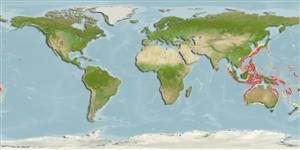Actinopterygii (ray-finned fishes) >
Perciformes (Perch-likes) >
Priacanthidae (Bigeyes or catalufas)
Etymology: Priacanthus: Greek, prion = saw + Greek, akantha = thorn (Ref. 45335).
Environment / Climate / Range
Ecology
Marine; demersal; depth range 150 - 400 m (Ref. 5403). Deep-water, preferred ?
Western Pacific: southern Japan to northwestern Australia.
Size / Weight / Age
Maturity: Lm ? range ? - ? cm
Max length : 18.5 cm SL male/unsexed; (Ref. 5403)
Dorsal
spines
(total): 10;
Dorsal
soft rays
(total): 13;
Anal
spines: 3;
Anal
soft rays: 13 - 14. Medium-sized fish. The body is oval; dorsal fin continuous; eyes very large; mouth large and oblique, with the lower jaw projecting upwards. The head and body silvery red or pink; iris of eyes red. The fins are creamy pink; the last 4-5 soft rays of the dorsal and anal fins are clearly white. This species resembles P. macracanthus with a long and narrow preopercular spine, but has less body depth, a narrower caudal peduncle, and fainter yellowish spots on its dorsal, anal and pelvic fins.
A deeper water species trawled from relatively open bottoms at depths of 150 to over 400 m.
Life cycle and mating behavior
Maturity | Reproduction | Spawning | Eggs | Fecundity | Larvae
Starnes, W.C., 1988. Revision, phylogeny and biogeographic comments on the circumtropical marine percoid fish family Priacanthidae. Bull. Mar. Sci. 43(2):117-203. (Ref. 5403)
IUCN Red List Status (Ref. 115185)
CITES (Ref. 94142)
Not Evaluated
Threat to humans
Harmless
Human uses
Fisheries: of no interest
More information
Common namesSynonymsMetabolismPredatorsEcotoxicologyReproductionMaturitySpawningFecundityEggsEgg development
ReferencesAquacultureAquaculture profileStrainsGeneticsAllele frequenciesHeritabilityDiseasesProcessingMass conversion
Tools
Special reports
Download XML
Internet sources
